Planetary Boundaries and the Trajectory of Sustainable Development
VerifiedAdded on 2023/06/05
|7
|1386
|423
Essay
AI Summary
This essay delves into the concept of planetary boundaries, which define the safe operating space for humanity regarding Earth's system processes. It identifies nine critical boundaries, including climate change, biosphere integrity, and freshwater consumption. The essay further discusses sustainable development as a means to meet present needs without compromising future generations' ability to meet their own. It examines the environmental, economic, and social pillars of sustainable development and explores paradigmatic transformations necessary to stay within planetary boundaries, such as energy transformation, food security transformation, urban sustainability transformation, population transformation and biodiversity management transformation. The essay also touches on the cognitive and affective dimensions of planetary boundaries, emphasizing the importance of acquiring knowledge and promoting sustainable transformations to ensure a safe and prosperous future. Desklib offers a platform for students to explore similar solved assignments and study resources.
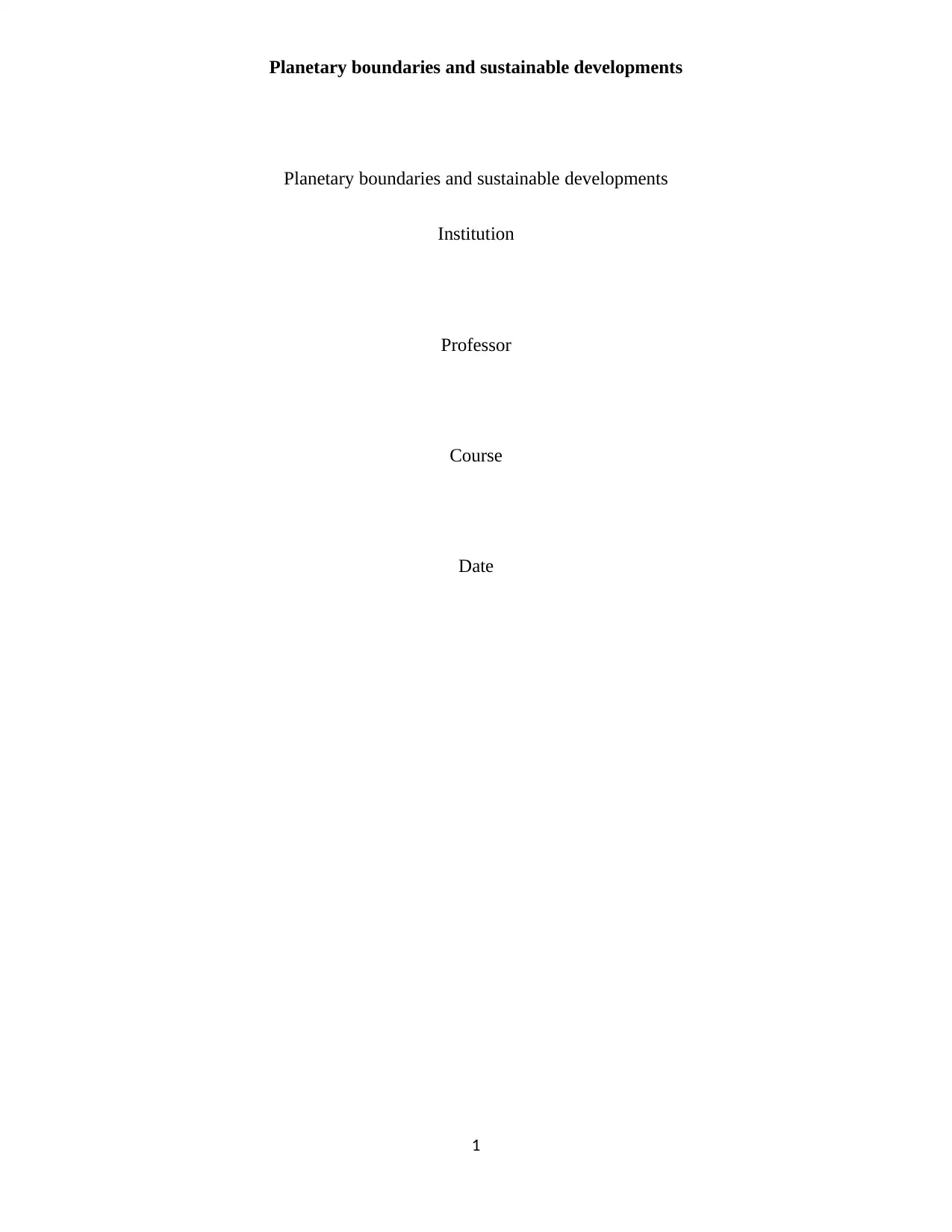
Planetary boundaries and sustainable developments
Planetary boundaries and sustainable developments
Institution
Professor
Course
Date
1
Planetary boundaries and sustainable developments
Institution
Professor
Course
Date
1
Paraphrase This Document
Need a fresh take? Get an instant paraphrase of this document with our AI Paraphraser
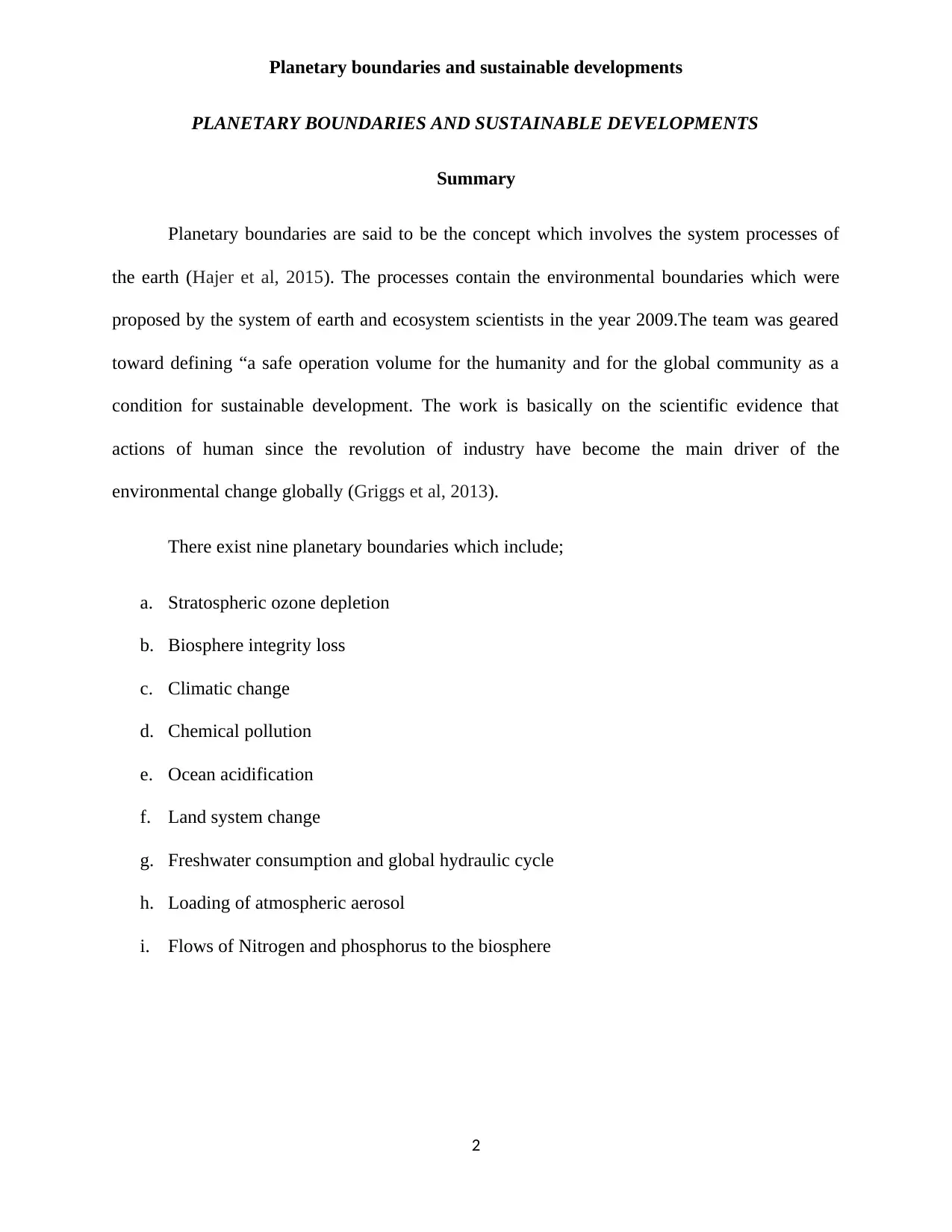
Planetary boundaries and sustainable developments
PLANETARY BOUNDARIES AND SUSTAINABLE DEVELOPMENTS
Summary
Planetary boundaries are said to be the concept which involves the system processes of
the earth (Hajer et al, 2015). The processes contain the environmental boundaries which were
proposed by the system of earth and ecosystem scientists in the year 2009.The team was geared
toward defining “a safe operation volume for the humanity and for the global community as a
condition for sustainable development. The work is basically on the scientific evidence that
actions of human since the revolution of industry have become the main driver of the
environmental change globally (Griggs et al, 2013).
There exist nine planetary boundaries which include;
a. Stratospheric ozone depletion
b. Biosphere integrity loss
c. Climatic change
d. Chemical pollution
e. Ocean acidification
f. Land system change
g. Freshwater consumption and global hydraulic cycle
h. Loading of atmospheric aerosol
i. Flows of Nitrogen and phosphorus to the biosphere
2
PLANETARY BOUNDARIES AND SUSTAINABLE DEVELOPMENTS
Summary
Planetary boundaries are said to be the concept which involves the system processes of
the earth (Hajer et al, 2015). The processes contain the environmental boundaries which were
proposed by the system of earth and ecosystem scientists in the year 2009.The team was geared
toward defining “a safe operation volume for the humanity and for the global community as a
condition for sustainable development. The work is basically on the scientific evidence that
actions of human since the revolution of industry have become the main driver of the
environmental change globally (Griggs et al, 2013).
There exist nine planetary boundaries which include;
a. Stratospheric ozone depletion
b. Biosphere integrity loss
c. Climatic change
d. Chemical pollution
e. Ocean acidification
f. Land system change
g. Freshwater consumption and global hydraulic cycle
h. Loading of atmospheric aerosol
i. Flows of Nitrogen and phosphorus to the biosphere
2
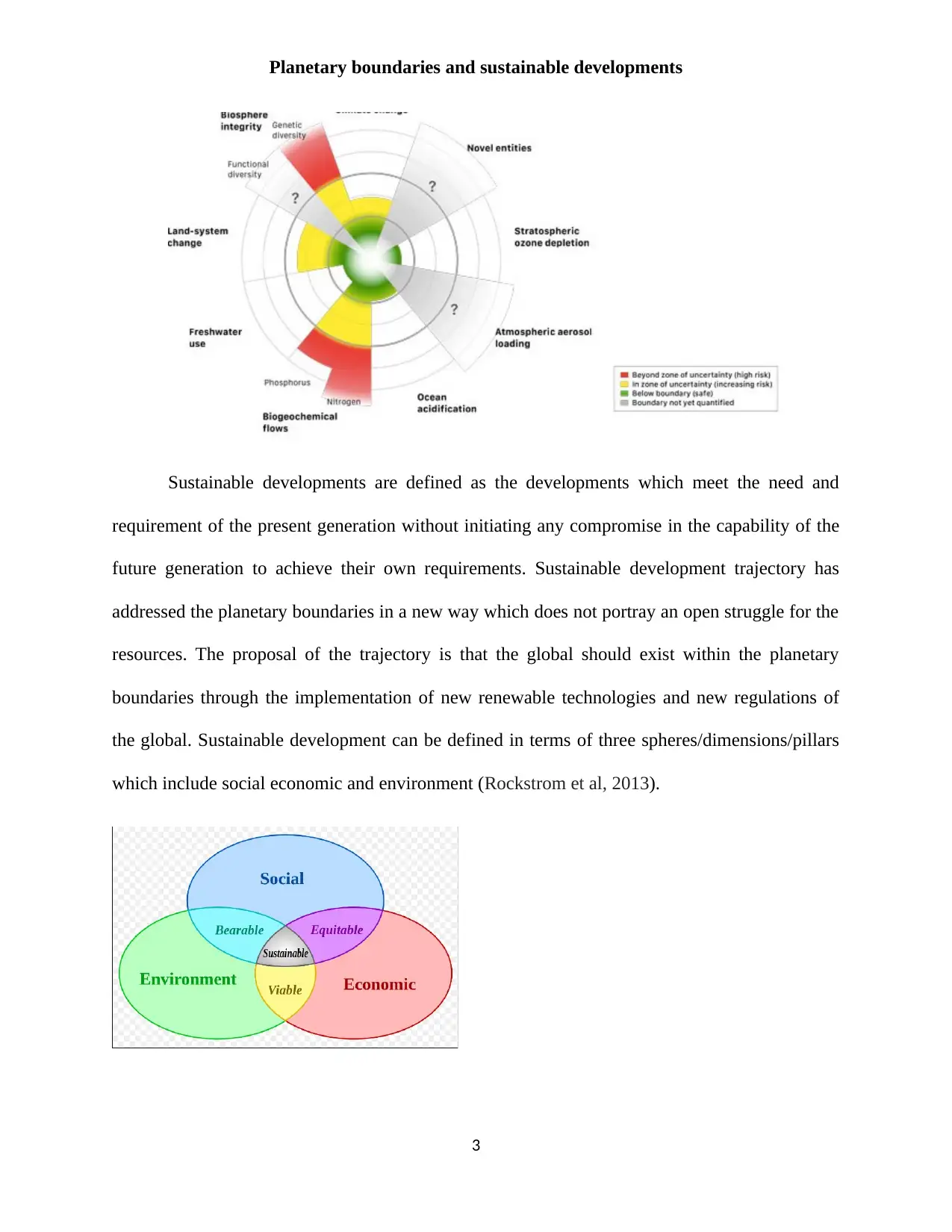
Planetary boundaries and sustainable developments
Sustainable developments are defined as the developments which meet the need and
requirement of the present generation without initiating any compromise in the capability of the
future generation to achieve their own requirements. Sustainable development trajectory has
addressed the planetary boundaries in a new way which does not portray an open struggle for the
resources. The proposal of the trajectory is that the global should exist within the planetary
boundaries through the implementation of new renewable technologies and new regulations of
the global. Sustainable development can be defined in terms of three spheres/dimensions/pillars
which include social economic and environment (Rockstrom et al, 2013).
3
Sustainable developments are defined as the developments which meet the need and
requirement of the present generation without initiating any compromise in the capability of the
future generation to achieve their own requirements. Sustainable development trajectory has
addressed the planetary boundaries in a new way which does not portray an open struggle for the
resources. The proposal of the trajectory is that the global should exist within the planetary
boundaries through the implementation of new renewable technologies and new regulations of
the global. Sustainable development can be defined in terms of three spheres/dimensions/pillars
which include social economic and environment (Rockstrom et al, 2013).
3
⊘ This is a preview!⊘
Do you want full access?
Subscribe today to unlock all pages.

Trusted by 1+ million students worldwide
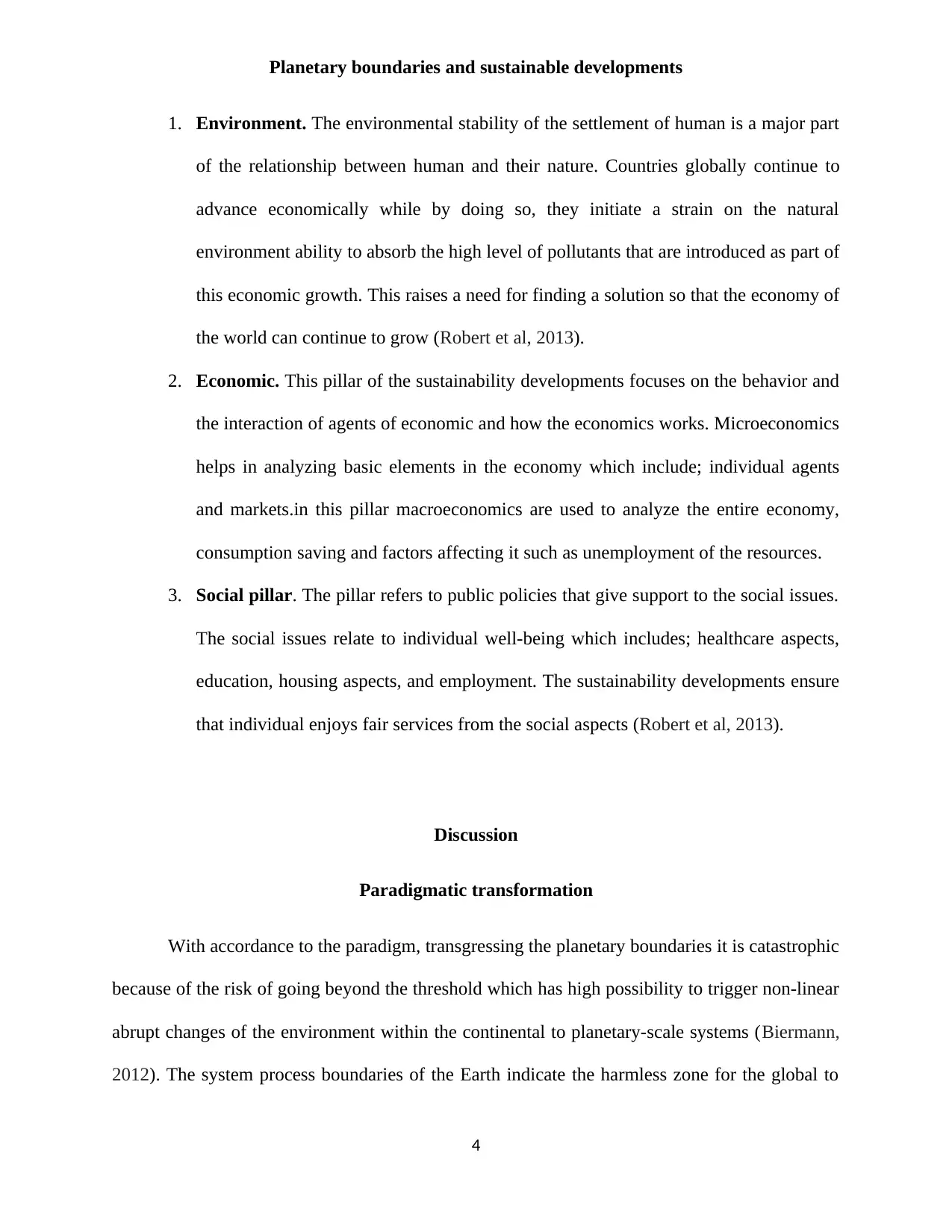
Planetary boundaries and sustainable developments
1. Environment. The environmental stability of the settlement of human is a major part
of the relationship between human and their nature. Countries globally continue to
advance economically while by doing so, they initiate a strain on the natural
environment ability to absorb the high level of pollutants that are introduced as part of
this economic growth. This raises a need for finding a solution so that the economy of
the world can continue to grow (Robert et al, 2013).
2. Economic. This pillar of the sustainability developments focuses on the behavior and
the interaction of agents of economic and how the economics works. Microeconomics
helps in analyzing basic elements in the economy which include; individual agents
and markets.in this pillar macroeconomics are used to analyze the entire economy,
consumption saving and factors affecting it such as unemployment of the resources.
3. Social pillar. The pillar refers to public policies that give support to the social issues.
The social issues relate to individual well-being which includes; healthcare aspects,
education, housing aspects, and employment. The sustainability developments ensure
that individual enjoys fair services from the social aspects (Robert et al, 2013).
Discussion
Paradigmatic transformation
With accordance to the paradigm, transgressing the planetary boundaries it is catastrophic
because of the risk of going beyond the threshold which has high possibility to trigger non-linear
abrupt changes of the environment within the continental to planetary-scale systems (Biermann,
2012). The system process boundaries of the Earth indicate the harmless zone for the global to
4
1. Environment. The environmental stability of the settlement of human is a major part
of the relationship between human and their nature. Countries globally continue to
advance economically while by doing so, they initiate a strain on the natural
environment ability to absorb the high level of pollutants that are introduced as part of
this economic growth. This raises a need for finding a solution so that the economy of
the world can continue to grow (Robert et al, 2013).
2. Economic. This pillar of the sustainability developments focuses on the behavior and
the interaction of agents of economic and how the economics works. Microeconomics
helps in analyzing basic elements in the economy which include; individual agents
and markets.in this pillar macroeconomics are used to analyze the entire economy,
consumption saving and factors affecting it such as unemployment of the resources.
3. Social pillar. The pillar refers to public policies that give support to the social issues.
The social issues relate to individual well-being which includes; healthcare aspects,
education, housing aspects, and employment. The sustainability developments ensure
that individual enjoys fair services from the social aspects (Robert et al, 2013).
Discussion
Paradigmatic transformation
With accordance to the paradigm, transgressing the planetary boundaries it is catastrophic
because of the risk of going beyond the threshold which has high possibility to trigger non-linear
abrupt changes of the environment within the continental to planetary-scale systems (Biermann,
2012). The system process boundaries of the Earth indicate the harmless zone for the global to
4
Paraphrase This Document
Need a fresh take? Get an instant paraphrase of this document with our AI Paraphraser
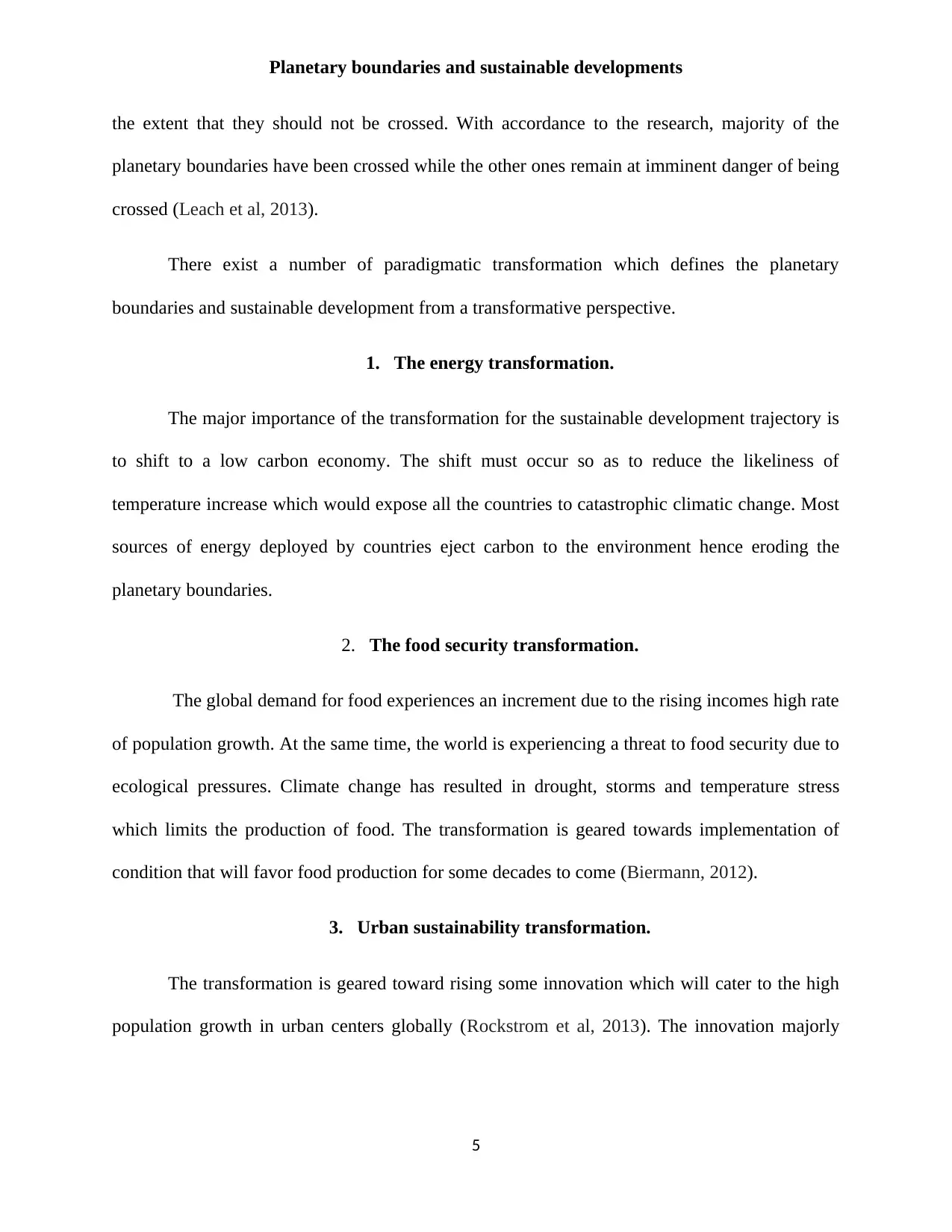
Planetary boundaries and sustainable developments
the extent that they should not be crossed. With accordance to the research, majority of the
planetary boundaries have been crossed while the other ones remain at imminent danger of being
crossed (Leach et al, 2013).
There exist a number of paradigmatic transformation which defines the planetary
boundaries and sustainable development from a transformative perspective.
1. The energy transformation.
The major importance of the transformation for the sustainable development trajectory is
to shift to a low carbon economy. The shift must occur so as to reduce the likeliness of
temperature increase which would expose all the countries to catastrophic climatic change. Most
sources of energy deployed by countries eject carbon to the environment hence eroding the
planetary boundaries.
2. The food security transformation.
The global demand for food experiences an increment due to the rising incomes high rate
of population growth. At the same time, the world is experiencing a threat to food security due to
ecological pressures. Climate change has resulted in drought, storms and temperature stress
which limits the production of food. The transformation is geared towards implementation of
condition that will favor food production for some decades to come (Biermann, 2012).
3. Urban sustainability transformation.
The transformation is geared toward rising some innovation which will cater to the high
population growth in urban centers globally (Rockstrom et al, 2013). The innovation majorly
5
the extent that they should not be crossed. With accordance to the research, majority of the
planetary boundaries have been crossed while the other ones remain at imminent danger of being
crossed (Leach et al, 2013).
There exist a number of paradigmatic transformation which defines the planetary
boundaries and sustainable development from a transformative perspective.
1. The energy transformation.
The major importance of the transformation for the sustainable development trajectory is
to shift to a low carbon economy. The shift must occur so as to reduce the likeliness of
temperature increase which would expose all the countries to catastrophic climatic change. Most
sources of energy deployed by countries eject carbon to the environment hence eroding the
planetary boundaries.
2. The food security transformation.
The global demand for food experiences an increment due to the rising incomes high rate
of population growth. At the same time, the world is experiencing a threat to food security due to
ecological pressures. Climate change has resulted in drought, storms and temperature stress
which limits the production of food. The transformation is geared towards implementation of
condition that will favor food production for some decades to come (Biermann, 2012).
3. Urban sustainability transformation.
The transformation is geared toward rising some innovation which will cater to the high
population growth in urban centers globally (Rockstrom et al, 2013). The innovation majorly
5
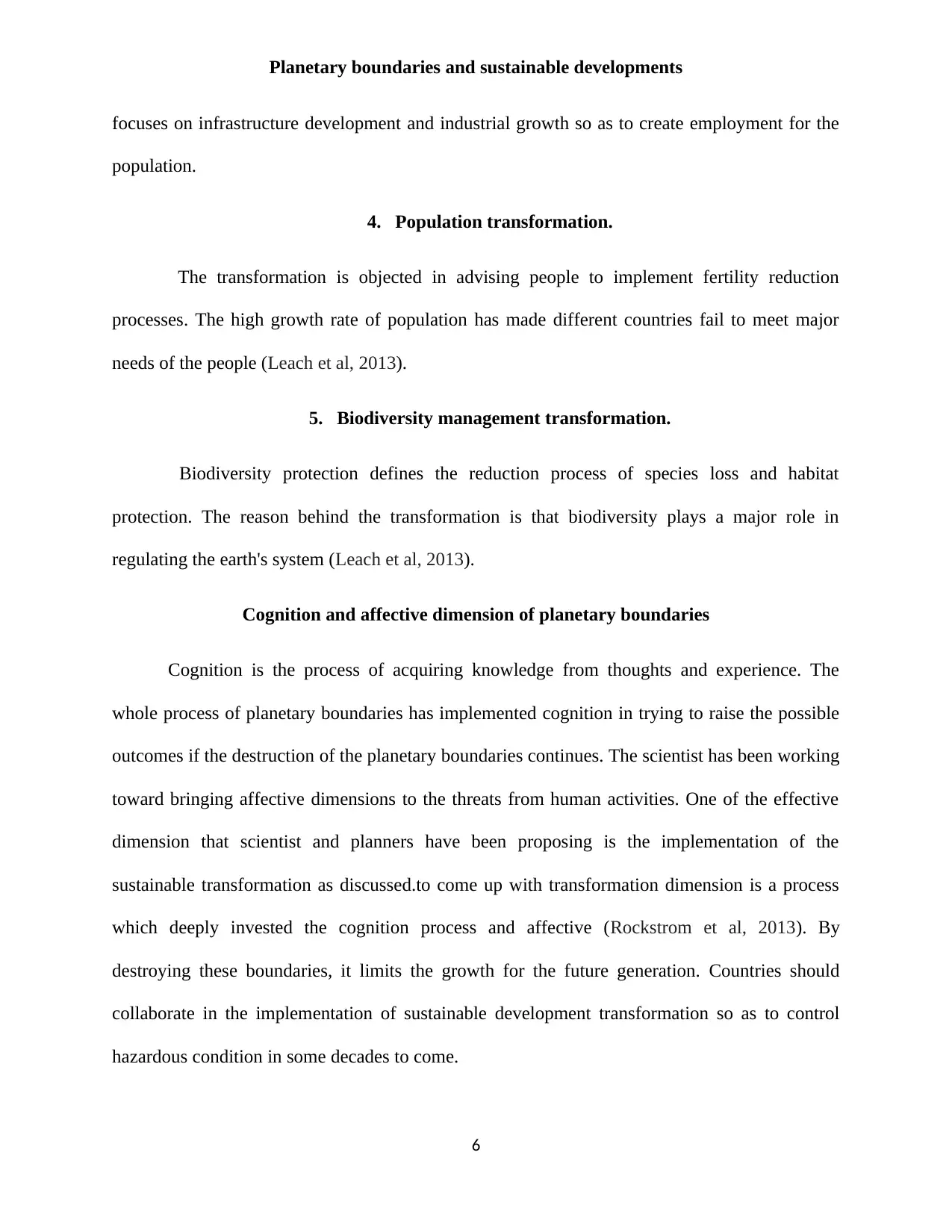
Planetary boundaries and sustainable developments
focuses on infrastructure development and industrial growth so as to create employment for the
population.
4. Population transformation.
The transformation is objected in advising people to implement fertility reduction
processes. The high growth rate of population has made different countries fail to meet major
needs of the people (Leach et al, 2013).
5. Biodiversity management transformation.
Biodiversity protection defines the reduction process of species loss and habitat
protection. The reason behind the transformation is that biodiversity plays a major role in
regulating the earth's system (Leach et al, 2013).
Cognition and affective dimension of planetary boundaries
Cognition is the process of acquiring knowledge from thoughts and experience. The
whole process of planetary boundaries has implemented cognition in trying to raise the possible
outcomes if the destruction of the planetary boundaries continues. The scientist has been working
toward bringing affective dimensions to the threats from human activities. One of the effective
dimension that scientist and planners have been proposing is the implementation of the
sustainable transformation as discussed.to come up with transformation dimension is a process
which deeply invested the cognition process and affective (Rockstrom et al, 2013). By
destroying these boundaries, it limits the growth for the future generation. Countries should
collaborate in the implementation of sustainable development transformation so as to control
hazardous condition in some decades to come.
6
focuses on infrastructure development and industrial growth so as to create employment for the
population.
4. Population transformation.
The transformation is objected in advising people to implement fertility reduction
processes. The high growth rate of population has made different countries fail to meet major
needs of the people (Leach et al, 2013).
5. Biodiversity management transformation.
Biodiversity protection defines the reduction process of species loss and habitat
protection. The reason behind the transformation is that biodiversity plays a major role in
regulating the earth's system (Leach et al, 2013).
Cognition and affective dimension of planetary boundaries
Cognition is the process of acquiring knowledge from thoughts and experience. The
whole process of planetary boundaries has implemented cognition in trying to raise the possible
outcomes if the destruction of the planetary boundaries continues. The scientist has been working
toward bringing affective dimensions to the threats from human activities. One of the effective
dimension that scientist and planners have been proposing is the implementation of the
sustainable transformation as discussed.to come up with transformation dimension is a process
which deeply invested the cognition process and affective (Rockstrom et al, 2013). By
destroying these boundaries, it limits the growth for the future generation. Countries should
collaborate in the implementation of sustainable development transformation so as to control
hazardous condition in some decades to come.
6
⊘ This is a preview!⊘
Do you want full access?
Subscribe today to unlock all pages.

Trusted by 1+ million students worldwide
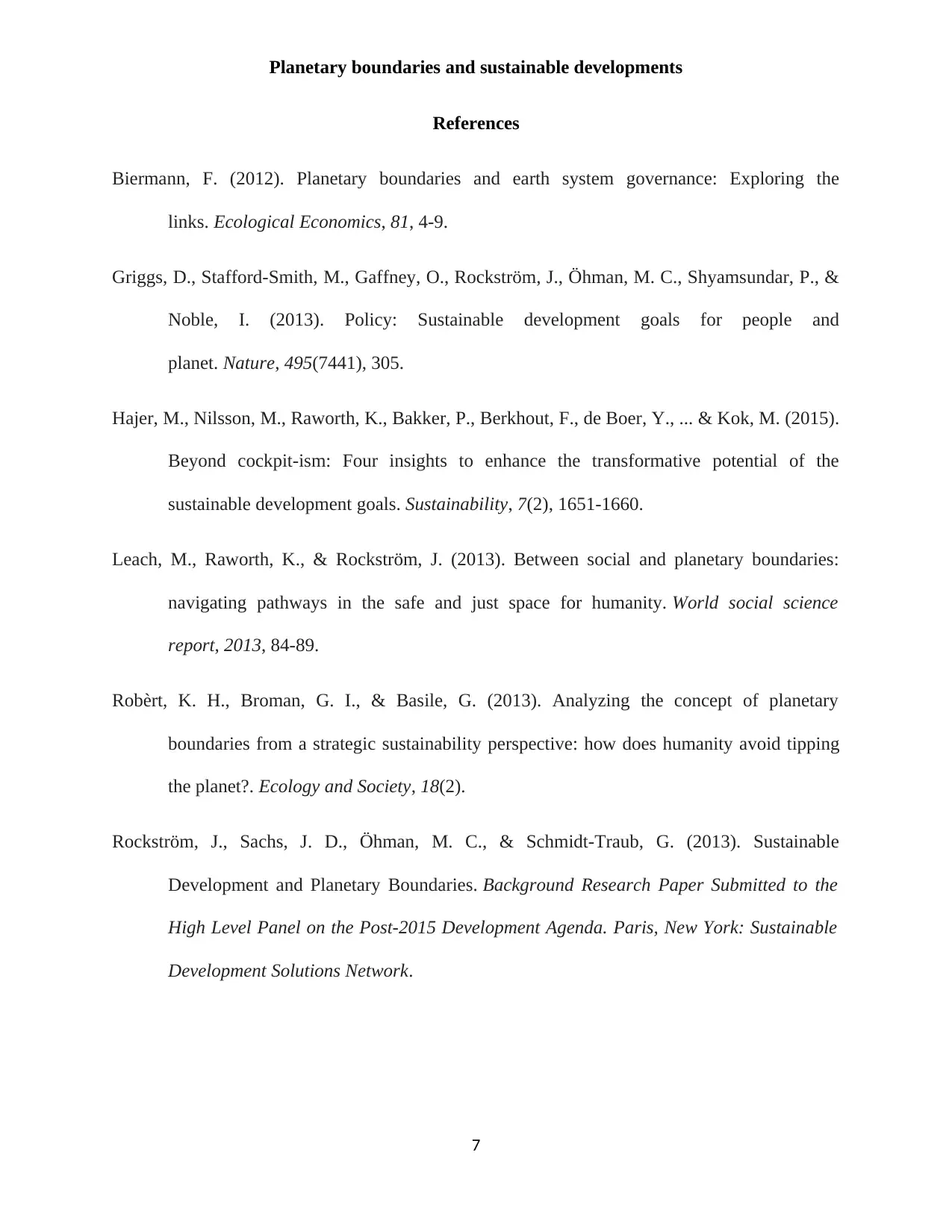
Planetary boundaries and sustainable developments
References
Biermann, F. (2012). Planetary boundaries and earth system governance: Exploring the
links. Ecological Economics, 81, 4-9.
Griggs, D., Stafford-Smith, M., Gaffney, O., Rockström, J., Öhman, M. C., Shyamsundar, P., &
Noble, I. (2013). Policy: Sustainable development goals for people and
planet. Nature, 495(7441), 305.
Hajer, M., Nilsson, M., Raworth, K., Bakker, P., Berkhout, F., de Boer, Y., ... & Kok, M. (2015).
Beyond cockpit-ism: Four insights to enhance the transformative potential of the
sustainable development goals. Sustainability, 7(2), 1651-1660.
Leach, M., Raworth, K., & Rockström, J. (2013). Between social and planetary boundaries:
navigating pathways in the safe and just space for humanity. World social science
report, 2013, 84-89.
Robèrt, K. H., Broman, G. I., & Basile, G. (2013). Analyzing the concept of planetary
boundaries from a strategic sustainability perspective: how does humanity avoid tipping
the planet?. Ecology and Society, 18(2).
Rockström, J., Sachs, J. D., Öhman, M. C., & Schmidt-Traub, G. (2013). Sustainable
Development and Planetary Boundaries. Background Research Paper Submitted to the
High Level Panel on the Post-2015 Development Agenda. Paris, New York: Sustainable
Development Solutions Network.
7
References
Biermann, F. (2012). Planetary boundaries and earth system governance: Exploring the
links. Ecological Economics, 81, 4-9.
Griggs, D., Stafford-Smith, M., Gaffney, O., Rockström, J., Öhman, M. C., Shyamsundar, P., &
Noble, I. (2013). Policy: Sustainable development goals for people and
planet. Nature, 495(7441), 305.
Hajer, M., Nilsson, M., Raworth, K., Bakker, P., Berkhout, F., de Boer, Y., ... & Kok, M. (2015).
Beyond cockpit-ism: Four insights to enhance the transformative potential of the
sustainable development goals. Sustainability, 7(2), 1651-1660.
Leach, M., Raworth, K., & Rockström, J. (2013). Between social and planetary boundaries:
navigating pathways in the safe and just space for humanity. World social science
report, 2013, 84-89.
Robèrt, K. H., Broman, G. I., & Basile, G. (2013). Analyzing the concept of planetary
boundaries from a strategic sustainability perspective: how does humanity avoid tipping
the planet?. Ecology and Society, 18(2).
Rockström, J., Sachs, J. D., Öhman, M. C., & Schmidt-Traub, G. (2013). Sustainable
Development and Planetary Boundaries. Background Research Paper Submitted to the
High Level Panel on the Post-2015 Development Agenda. Paris, New York: Sustainable
Development Solutions Network.
7
1 out of 7
Related Documents
Your All-in-One AI-Powered Toolkit for Academic Success.
+13062052269
info@desklib.com
Available 24*7 on WhatsApp / Email
![[object Object]](/_next/static/media/star-bottom.7253800d.svg)
Unlock your academic potential
Copyright © 2020–2025 A2Z Services. All Rights Reserved. Developed and managed by ZUCOL.





